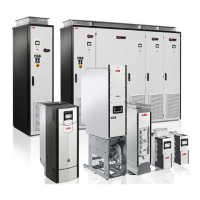Standard programposi features 57
Settings
See parameter groups:
• 14 I/O extension module 1
• 15 I/O extension module 2
• 16 I/O extension module 3
Fieldbus control
The drive is connected to several different automation systems through its fieldbus
interfaces. See chapter Fieldbus control through a fieldbus adapter (page 461) and
Fieldbus control through a fieldbus adapter (page 461).
Settings
See parameter groups
• 50 Fieldbus adapter (FBA)
• 51 FBA A settings
• 52 FBA A data in
• 53 FBA A data out
• 54 FBA B settings
• 55 FBA B data in
• 56 FBA B data out
• 58 Embedded fieldbus
Motor control
Direct torque control (DTC)
The motor control of the ACS880 is based on direct torque control (DTC). The
switching of the output semiconductors is controlled to achieve the required stator
flux and motor torque. The switching frequency is changed only if the actual torque
and stator flux values differ from their reference values by more than the allowed
hysteresis. The reference value for the torque controller comes from the speed
controller or directly from an external torque reference source.
Motor control requires measurement of DC voltage and two motor phase currents.
Stator flux is calculated by integrating the motor voltage in vector space. Motor torque
is calculated as a cross product of the stator flux and the rotor current. By utilizing the
identified motor model, the stator flux estimate is improved. Actual motor shaft speed
is not needed for motor control.
The main difference between traditional control and DTC is that torque control has
the same time level as the power switch control. There is no separate voltage and
frequency controlled PWM modulator. The output stage switching is based on the
electromagnetic state of the motor.

